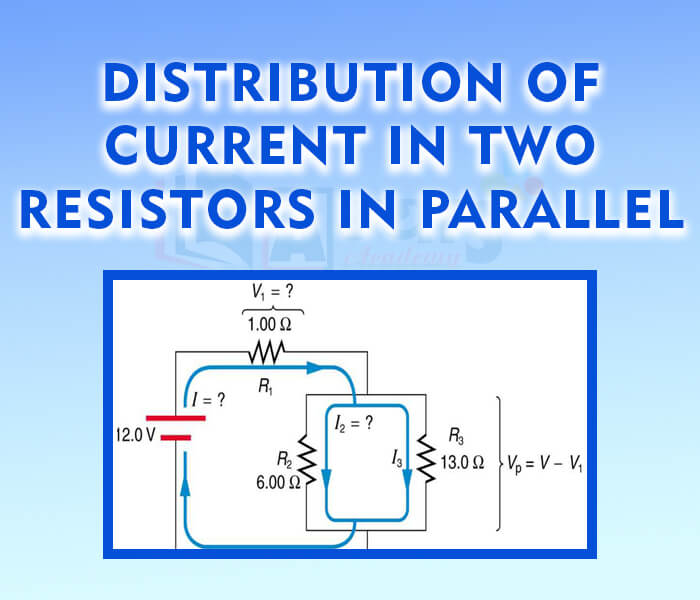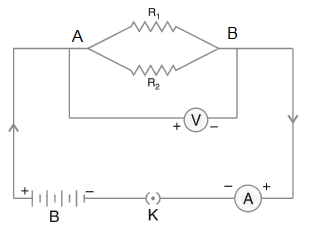Distribution of Current in Two Resistors in Parallel







Distribution of Current in Two Resistors in Parallel
In the case of a parallel combination of resistance the current is divided into different paths and the sum of current passing through each resistance is equal to the total current through the circuit. Now let us derive a relation between current and resistance to calculate the amount of current passing through each resistance. In the circuit below we have two resistance R1 and R2 connected in parallel.

The resistors R1 and R2 are connected in parallel. The current I gets distributed in the two resistors. Let I1 and I2 be the current flowing through the resistors R1 and R2 respectively. As the resistance are connected in parallel so the sum of the current flowing through two resistance is equal to the total current flowing in the circuit. So we have
. (i)
Applying Ohm s law to the resistor ,
(ii)
And applying Ohm s law to the resistor ,
. (iii)
From (ii) and (iii) we get
.
Substituting for I2 in (i), we have
or
Similarly,
Thus,
The current through each branch in a parallel combination of resistors is inversely proportional to its resistance.
Illustration: Two resistors of resistances R1 and R2 having resistance 10 ohms and 20 ohms respectively are connected in parallel. A battery supplies 6 A of current to the combination, as shown in fig. Calculate the current in each resistor.

Solution: As the two resistance are connected in parallel the current in the resistance can be calculated as follows
The current in the resistor is
The current in the resistor is
Two resistors are connected in series to 25 volt battery, and an ammeter in the circuit reads 0.50 A. The first resistor is rated at 22 ohms. Find :- (a) the total resistance (b) the resistance of the second resistor (c) the potential difference across the second resistor. | |||
| Right Option : C | |||
| View Explanation | |||
In parallel combination of resistance the total current flowing through the circuit is equal to _____________________________.
| |||
| Right Option : B | |||
| View Explanation | |||
The potential difference between the terminals of an electric heater is 50 V when it draws a current of 6 A from the source.What current will the heater draw if the potential difference is increased to 110 V ? | |||
| Right Option : C | |||
| View Explanation | |||
Students / Parents Reviews [20]
It was a good experience with Abhyas Academy. I even faced problems in starting but slowly and steadily overcomed. Especially reasoning classes helped me a lot.

Cheshta
10thMy experience was very good with Abhyas academy. I am studying here from 6th class and I am satisfied by its results in my life. I improved a lot here ahead of school syllabus.

Ayan Ghosh
8thAbhyas is a complete education Institute. Here extreme care is taken by teacher with the help of regular exam. Extra classes also conducted by the institute, if the student is weak.

Om Umang
10thMy experience with Abhyas Academy has been very good. When I was not in Abhyas whenever teacher ask questions I could not speak it confidently but when I came in Abhyas, my speaking skills developed and now I am the first one to give the answer of teachers question.

Upmanyu Sharma
7thWhen I have not joined Abhyas Academy, my skills of solving maths problems were not clear. But, after joining it, my skills have been developed and my concepts of science and SST are very well. I also came to know about other subjects such as vedic maths and reasoning.

Sharandeep Singh
7thMy experience with Abhyas academy is very nice or it can be said wonderful. I have been studying here from seven class. I have been completing my journey of three years. I am tinking that I should join Abhyas Academy in tenth class as I am seeing much improvement in Maths and English

Hridey Preet
9thMy experience with Abhyas academy is very good. I did not think that my every subject coming here will be so strong. The main thing is that the online tests had made me learn here more things.

Hiya Gupta
8thAbhyas institute is one of the best coaching institute in the vicinity of Ambala Cantt area. The teachers of the institute are well experienced and very helpful in solving the problems of the students.The good thing of the institute is that it is providing extra classes for the students who are w...

Aman Kumar Shrivastava
10thUsually we see institutes offering objective based learning which usually causes a lag behind in subjective examinations which is the pattern followed by schools. I think it is really a work of planning to make us students grab the advantages of modes of examination, Objective Subjective and Onli...

Anika Saxena
8thI have spent a wonderful time in Abhyas academy. It has made my reasoning more apt, English more stronger and Maths an interesting subject for me. It has given me a habbit of self studying

Yatharthi Sharma
10thAbhyas academy is great place to learn. I have learnt a lot here they have finished my fear of not answering.It has created a habit of self studying in me.The teachers here are very supportive and helpful. Earlier my maths and science was good but now it has been much better than before.

Barkha Arora
10thWe started with lot of hope that Abhyas will help in better understnding of complex topics of highers classes. we are not disappointed with the progress our child has made after attending Abhyas. Though need to mention that we expected a lot more. On a scale of 1-10, we would give may be 7.

Manya
8thIt has a great methodology. Students here can get analysis to their test quickly.We can learn easily through PPTs and the testing methods are good. We know that where we have to practice

Barkha Arora
10thThe experience was nice. I studied here for three years and saw a tremendous change in myself. I started liking subjects like English and SST which earlier I ran from. Extra knowledge gave me confidence to overcome competitive exams. One of the best institutes for secondary education.

Aman Kumar Shrivastava
10thAbhyas is an institute of high repute. Yogansh has taken admission last year. It creates abilities in child to prepare for competitive exams. Students are motivated by living prizes on basis of performance in Abhyas exams. He is satisfied with institute.

Yogansh Nyasi
7thAbhyas Methodology is very good. It is based on according to student and each child manages accordingly to its properly. Methodology has improved the abilities of students to shine them in future.

Manish Kumar
10thOne of the best institutes to develope a child interest in studies.Provides SST and English knowledge also unlike other institutes. Teachers are co operative and friendly online tests andPPT develope practical knowledge also.

Aman Kumar Shrivastava
10thA marvelous experience with Abhyas. I am glad to share that my ward has achieved more than enough at the Ambala ABHYAS centre. Years have passed on and more and more he has gained. May the centre flourish and develop day by day by the grace of God.

Archit Segal
7thAbout Abhyas metholodology the teachers are very nice and hardworking toward students.The Centre Head Mrs Anu Sethi is also a brilliant teacher.Abhyas has taught me how to overcome problems and has always taken my doubts and suppoeted me.

Shreya Shrivastava
8thMy experience with Abhyas is very good. I have learnt many things here like vedic maths and reasoning also. Teachers here first take our doubts and then there are assignments to verify our weak points.
